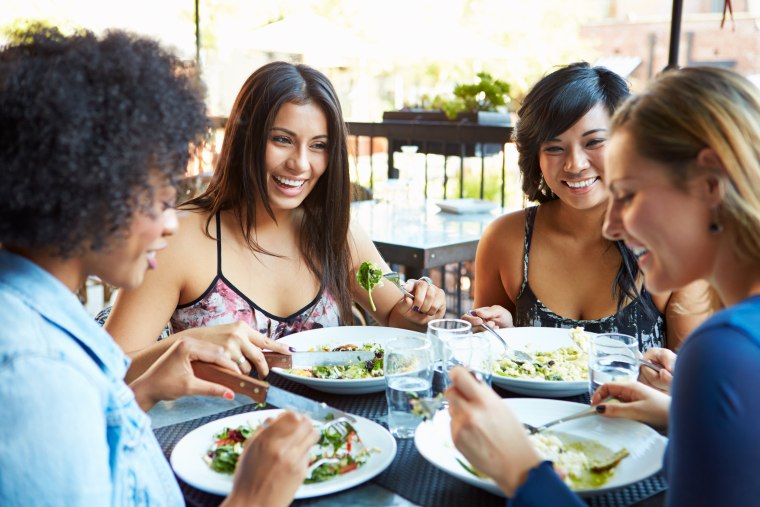Health and fitness writer Julia Malacoff has changed the way she talks about food, and lost 10 pounds in the process.
The 28-year-old said she used to talk about food as either “good” or “bad,” she says, which caused her to have an unhealthy relationship with food. Whenever she ate something she considered “bad,” she says, it made her feel guilty, and she would overindulge as a result.
“I would get into this cycle of eating mostly healthy food, but then, at night, I would eat nachos for dinner,” Malacoff told NBC News BETTER. “So it was sort of like I was just having a hard time balancing eating foods that made me feel good physically and eating the foods that I thought were really delicious.”

Malacoff says she only wanted to lose a few extra pounds. She tried all the latest weight loss trends, she says, but none worked. The real problem, she eventually realized, was the way she thought about food.
“I just think it’s so crazy to me as a person who knows a lot about health and fitness, that I didn’t realize that just eating the way I normally eat but changing the way I think about it would be key to actually feeling better about food,” she says.
If you find yourself often feeling guilty about what you eat, the writer suggests making a few key changes to the way you think and talk about food.
Free yourself from “all or nothing thinking”
Malacoff realized that talking about foods as if they are either good or bad was part of an “all or nothing” mentality that lead to a cycle of guilt around how she ate.
After eliminating negative phrases like “cheat days” and “cheat meals” from her vocabulary, she said, eating became pleasurable. Feelings of guilt and anxiety around eating went away, she explained, and so did the urge to overindulge.
“When I used to do something like that — like have an indulgent meal — I would think to myself, ‘This is so bad, it’s the beginning of the end of my diet, I don’t know when I’m going to be able to have this food again,’ things like that,” she says.
“Now when I eat something that’s really delicious and indulgent, I think ‘I really like this, it’s so delicious, I’m enjoying my time with my friends, and next week, when I have another indulgent meal, I might eat this again.’ So I’m not thinking, ‘I’m never going to eat this food again, so I need to eat as much as I possibly can,’” she explains.
The important thing to understand, she says, is all foods can be part of a healthy diet — it’s simply a matter of balancing them out.
Learn the “Stoplight System”
Malacoff recommends the “stoplight system” for anyone who has negative thinking around food. The system, developed by psychologist Susan Albers, classifies foods as either “green light,” “yellow light,” or “red light,” she says, and makes it easier to look at foods objectively.
“Green light”: These are foods like fruits, vegetables, whole grains, and lean proteins. You can “always feel awesome about eating” these foods, according to Malacoff. “These are the foods that are going to help me reach my goal, so I want to eat them as much as possible,” she says.
“Yellow light”: These are the “in-between” foods, explains the writer. “They’re not necessarily harmful for your goals, but you want to eat them in moderation because they’re not helping as much as the green light foods,” she says.
“Red light foods”: What we would consider foods with the least nutritional value, these foods are for occasional indulgences only, explains Malacoff. “[The] things that you love eating, but maybe you’re going to settle it on how many times per week you’re going to eat them.”
Measure your progress with more than a scale
Language isn’t the only thing that shapes our attitudes about food — so can the number on the scale, according to Malacoff. Your weight may fluctuate, she says, especially if you are working out and putting on lean muscle.
Instead of tracking your progress on the scale alone, Malacoff recommends measuring your waist size and taking photos of yourself each week.
“I really feel that when you use all three of those things together it takes the power away from the number you’re seeing on the scale because …let’s say you haven’t lost any weight in a week but you look at your photo from when you started three or four months ago and your body looks significantly different — then it’s much easier to be like, ‘Oh, ok, the number of my weight is not as important.’
She says it’s also important to track what you eat on an app like MyFitnessPal so you can clearly see how your diet is affecting your weight.
“I tracked everything, even meals that were really indulgent that did not fit into my calorie or macro goals for the day, and that was another way for me to sort of see…that I could still meet my goals and eat those foods,” Malacoff says.
It takes time, but it’s worth it
After changing how she talked about food, Malacoff started to see the pounds come off. She says it took about six months to lose 10 pounds, but it was worth it.
“It feels great,” Malacoff says, “and I definitely feel a lot more in control of my relationship with food than I did before.”
How to change the way you talk about food:
- Change your mentality: Talking about foods as either “good” or “bad” is part of an “all or nothing” mentality that can lead to a cycle of guilt around how you eat.
- Learn the “Stoplight System”: The system, which classifies foods as either “green light,” “yellow light,” or “red light,” will help you look at food objectively. “Green light” foods are healthy foods like fruits, vegetables, whole grains, and lean proteins, which you can eat as much as you want. “Yellow light” foods are foods that are not necessarily harmful to your goals, but should be eaten in moderation. “Red light” foods are foods with the least nutritional value and are fine to eat on occasion.
- Don't rely solely on the scale: Language isn’t the only thing that shapes our attitudes about food — so can the number on the scale. It’s natural for your weight to fluctuate. The best way to understand your progress is to measure yourself and take photos in addition to weighing yourself. Track your weight in an app like MyFitnesPal so you can clearly see how your diet is affecting your weight.
WANT TO EAT BETTER? TRY THESE SIMPLE SWAPS:
- How to Make Healthy Food Taste Delicious, According to a Celebrity Chef
- Research Says This One Trick Will Help You Eat More Veggies
- 5 Foolproof Principles for Cleaning Up Your Diet
- 8 Simple Swaps That'll Save you 100 Calories at Every Meal
Want more tips like these? NBC News BETTER is obsessed with finding easier, healthier and smarter ways to live. Sign up for our newsletter and follow us on Facebook, Twitter and Instagram.

